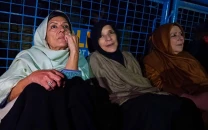Balochistan's flood -- not so natural a disaster
Man-made or natural disasters are the most common news we hear from the province

In recent years Balochistan has been in the news — for wrong reasons though. Man-made or natural disasters are the most common news we hear from Balochistan. Since the province has been in the grip of a violent separatist insurgency for decades, we pay scant attention to other issues. We only hear about Balochistan when there is a massive bombing or a natural disaster such as a flood or an earthquake.
It is the provincial government’s criminal lack of interest in adequately preparing for natural disasters that has brought 9 million of its population and 32 districts under water. Just a few months ago, several parts of Balochistan suffered severe drought — tube-wells and water resources had dried up, and there was no drinking water. In June, unprecedented rains changed everything.
The flood hit Jafarabad, Jhal Magsi and Lasbela districts the worst. Remember that the feudal lords rule all these three districts. Jams, Magsi, and Jamalis have been in power there for decades — in fact since the inception of Pakistan.
Balochistan is not uncommon to flood. The province has experienced flood-like situations in 2007, 2010 and 2012. What was unexpected was the unpreparedness of the provincial government — especially the district administration of Jaffarabad, Jhal Magsi and Lasbela — despite repeated warnings.
The recent flood only devastated the mud houses and killed a few hundred people. The fact is that extreme poverty, lack of employment opportunities, bad governance and poor infrastructure have long ago devastated the poor inhabitants of Balochistan.
Interestingly, the UNDP — in a damning report in 2018 — ranked the aforementioned districts, as well as Qilla Abdullah, on top in terms of multidimensional poverty. Another study by Professor Manzoor Ahmed of Lasbela University of Agriculture, Water, and Marine Science revealed that in Lasbela, there are 70% poor and 24.5% impoverished households. According to the 2020 study, per capita monthly income is hardly Rs1,500 in Lasbela from where Jams hail. I searched and asked people in Lasbela if they could present a single example of any development work Jams — who have held the CM’s position in the province many a time — have done for the welfare of his people. Nobody had an answer in the affirmative. The same goes for the Magis and Jamalis.
What the recent flood did was that it triggered a further loss of property and human displacement. But the rains — unprecedented though — cannot be solely blamed for that. Bad governance, corruption, poor infrastructure and absence of floodplains are equally to blame.
For example, heavy floods in Lasbela could have been mitigated or diverted if the Tharra Bund, built in the past to protect the Bela town, had been properly maintained. Similarly, if the Porali river in Bela town, a project of the World Bank, had been made with proper planning, the damage could have been far lesser. Poor management of Tharra Bund and Porali river resulted in more damage.
Balochistan can quickly mitigate extreme rainfall if we focus on improving the infrastructure and having a better water management system, especially in Jhal Magsi, Jafarabad and Naseerabad, where the centuries-old canals could not resist the flow of water, inundating several villages, as a result.
Unfortunately, much of the development funds allocated to MPAs in Balochistan go to corruption. After the security situation worsened in the province in early 2000, Balochistan received significant funds from the federal government under the NFC Award, but there was hardly any spending on the province’s infrastructure.
Funds worth millions of rupees are earmarked for legislators to carry out development in their constituencies, but it’s near impossible to find any signs of development and modern infrastructure in any part of Balochistan. Climate change is a reality, but the recent flood in Balochistan is a man-made disaster, requiring a proper focus on devising solutions that could last long.
Published in The Express Tribune, September 28th, 2022.
Like Opinion & Editorial on Facebook, follow @ETOpEd on Twitter to receive all updates on all our daily pieces.













COMMENTS
Comments are moderated and generally will be posted if they are on-topic and not abusive.
For more information, please see our Comments FAQ